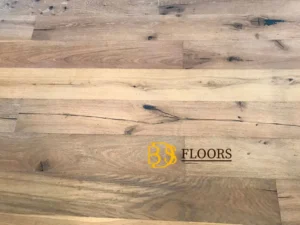If you want to maintain the appearance of your bamboo floors for an extended period of time, it’s important to clean them properly. Are Swiffer and vinegar effective cleaning solutions? Read on to discover the facts. Bamboo is becoming an increasingly popular flooring option due to its eco-friendliness and relatively quick harvest time of just five years. However, its durability can vary depending on the species and manufacturing processes used. Solid natural bamboo is incredibly sturdy and twice as hard as red oak, but carbonized or engineered bamboo flooring can be up to 30% weaker than natural bamboo and more prone to damage.
No matter which type of bamboo flooring you opt for, it will maintain its attractive appearance for a longer duration if you know how to clean and maintain it effectively. Safeguard your investment by utilizing these recommendations and strategies.
STEP 1: Remove debris with a broom or vacuum.
The first step to caring for your bamboo flooring is to sweep away any debris using a broom with soft bristles or fine fibers. It’s recommended to sweep at least once a day to prevent dirt and dust from scratching the floor’s surface. Vacuuming is also safe as long as you use a floor cleaning attachment or select the hard floor setting to avoid damage. Avoid using standard vacuums with heavy wheels and rotating brushes that can create scratches or dents. Bamboo flooring, like other hardwood and laminate flooring, is vulnerable to water damage. Therefore, it’s important to immediately clean up spills to prevent water from penetrating and damaging the wood fibers. Carbonized bamboo flooring, in particular, lacks the strength of standard bamboo flooring due to its manufacturing process of subjecting it to extreme heat to achieve a rich, dark hue.
STEP 2: Prepare a mop solution with bamboo floor cleaner.
For the second step in maintaining your bamboo floors, create a solution of bamboo floor cleaner and use a mop to clean once a week. It’s important to choose a hardwood-rated cleaner such as Bona or Murphy Oil Soap to preserve the shine and safeguard the surface. Avoid using cleaners that contain ammonia or vinegar and other acidic substances that may cause discoloration or harm the finish, which can leave the floors more vulnerable to additional damage. If the manufacturer’s instructions suggest dilution with water, ensure not to over-dilute the solution.
STEP 3: Remove any stains or scuffs.
Step three involves removing any stains or scuffs from your bamboo floors. Keep an eye out for these blemishes while you’re sweeping or vacuuming, as they may require additional attention. It’s crucial to sweep up any loose debris before attempting to remove the stains or scuffs to avoid grinding dirt into the floor’s surface. Detailed instructions for removing stains are provided below.
STEP 4: Mop the floor in sections.
Step four involves mopping the floor in sections. Before mopping, ensure that your mop is thoroughly wrung out to prevent liquid pooling on the floor. It’s important to use just enough water to avoid excessive moisture, which can cause expansion, cupping, or buckling in the cracks between planks.
STEP 5: Allow the floor to air-dry.
Step five requires you to allow the floor to air-dry naturally. Avoid using a rag or towel to manually dry the floor as this can cause swirl marks. It’s best to let the floor dry on its own, which shouldn’t take too long. Once it’s dry, refrain from applying any finishes or waxes unless specifically recommended by the flooring manufacturer. Applying unauthorized finishes or waxes could result in staining or damaging the flooring, and some manufacturers may even void the floor’s warranty in such cases.
Spills, Stains, and Scuffs on Bamboo Hardwood Floors
To ensure the longevity of your bamboo hardwood floor, it’s crucial to address spills, stains, and scuffs in a timely and effective manner. Here are some tips to clean bamboo floors without causing any damage.
Spills: Quickly absorb spills with a soft, dry cloth to prevent further damage. Then, clean the bamboo flooring with a lightly dampened fresh cloth and dry the area thoroughly.
If you have bamboo flooring in your kitchen or bathroom, it’s advisable to place a rug near the sink or other areas that are prone to spills or moisture. However, ensure that the rug is made of a breathable material without latex or rubber backing, which can cause discoloration or damage to the floor, especially if it’s a darker bamboo flooring.
Maintaining the pristine condition of your bamboo hardwood floor requires prompt action when spills, stains, or scuffs occur. However, the cleaning method you use should depend on the type of stain, the bamboo variety, and whether it has penetrated the finish or the wood. Using the wrong cleaning agent may worsen the problem.
Thankfully, you may find a useful cleaning solution in your kitchen. For instance, a small amount of real mayonnaise can remove some water stains or discolorations. Leave it for at least 15 minutes before wiping it off and polishing the area with a clean, soft cloth. If mayo does not work, avoid trying other home remedies as they can harm the bamboo floor.
For stubborn stains, you can refinish the bamboo floor to eliminate the discoloration. As for scuff marks, use a wood floor cleaner diluted as required to gently rub the area with a soft, dry cloth. Spot-dry the floor after cleaning, and your bamboo hardwood floor should look as good as new.
How to Maintain Natural and Engineered Bamboo Flooring
If you want to keep your bamboo flooring looking great for a long time, it’s essential to clean it regularly and take preventive measures. Here are some dos and don’ts to maintain your bamboo floors:
Maintenance Dos
- Trim your pets’ nails to prevent scratches.
- Avoid wearing shoes on your bamboo floors to prevent fine pebbles from scratching the surface.
- Place colorfast felt or furniture sliders under chairs and other furniture to avoid scratches.
- Maintain a relative humidity level of 30 to 50 percent to prevent swelling or drying of the bamboo.
Maintenance Don’ts
- Avoid using rubber- or latex-backed mats on bamboo floors as they can trap moisture and cause damage or discoloration.
- Stiletto heels and sports cleats can leave indentations on bamboo floors, especially carbonized bamboo.
- Protect your bamboo floors from sunlight as it can cause fading over time. Use curtains or blinds to filter sunlight.
- Never steam-clean your bamboo floors.
Final Thoughts
In conclusion, using the methods outlined in this article can help you remove scuffs and spills from your bamboo hardwood floors safely and effectively. It’s important to remember that not all cleaning products are suitable for bamboo floors, and using the wrong products can cause permanent damage or staining. To ensure the longevity of your bamboo floors, always use cleaning and polishing products recommended by the flooring manufacturer.
If you have questions about cleaning bamboo floors, here are some frequently asked questions and answers. First, it’s not recommended to use Swiffer WetJet on bamboo floors, as it may leave a film or brush marks. Bamboo is a durable flooring option that can last up to 50 years if well maintained. It’s also important to seal bamboo floors in the same way as hardwood floors, but never wax them as it can make them slippery. Finally, bamboo floors can separate due to changes in humidity, so proper installation and climate control are essential in preventing this from happening.
FAQs About Cleaning Bamboo Floors
Q: Can I use Swiffer WetJet on bamboo floors? A: While it may not cause damage, most flooring manufacturers recommend using a cleaner specifically made for bamboo floors to avoid leaving unsightly film or brush marks.
Q: How long do bamboo floors last? A: Bamboo is an extremely durable flooring material that can last up to 50 years with proper maintenance. Carbonized bamboo flooring, in particular, is made to withstand intense heat during the manufacturing process.
Q: Do bamboo floors need to be sealed? A: Yes, bamboo floors should be sealed just like hardwood floors.
Q: Can you wax bamboo floors? A: Waxing bamboo floors can leave a residue that makes them slippery. To make them shine, use a damp mop after cleaning, being careful not to let water pool on the floor.
Q: Why is my bamboo flooring separating? A: Changes in humidity can cause bamboo floors to shrink or expand, leading to separation. Proper installation, allowing planks to stabilize before installation, and maintaining a climate-controlled environment can help prevent this.
Q: Can you steam-clean bamboo floors? A: No, bamboo floors are not waterproof and can be damaged by water and steam.
Q: Is vinegar safe for bamboo floors? A: No, vinegar is acidic and can corrode and damage bamboo flooring. Use only pH-balanced cleaners recommended by the manufacturer.







